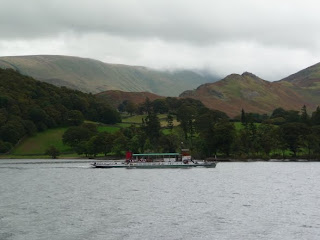 |
From our campsite, a lay-by at Deep Water, Ullswater (it wouldn't do to call them "lakes"), at the beginning of the Lake District, Sunday evening |
 |
A lake steamer chugs by near sunset |
 |
More of Ullswater |
 |
Castlerigg stone circle, near Keswick |
 |
Me, by the remains of one of the cairns within the circle |
September 28. We spent the morning picking blackberries along the lake and pondering future travels, complications engendered by the Schengen Agreement, distances, holidays, seasons, and so forth. A year or even a year-and-a-half is not nearly enough time to do everything we want to do here, and there is much of Europe in which we have little or no interest. And then there are questions of cost.
Rain is forecast for three days now, not the best time to see the Lake District, so we have decided to slow down, loaf, and do some of the peripherals. The latter include the Castlerigg stone circle, near Keswick, where Coleridge lived, and which we visited at lunch time. The weather is dismal grey, cool, raining, a ceiling so low you can't see the nearby mountains, yet there were a dozen cars here, people out in the middle of a valley of sheep pastures, looking at the 4,500 year old stones. The circle is fairly well intact, 20-some stones, none terribly large, but a beautiful site. Often, megalithic sites seem calculated to be the only thing of visual interest around. This one is different, set in a valley of surpassing Lake District beauty, even on an ugly (but probably normal) day.
After seeing Castlerigg, we drove into Keswick and shopped. It is a gateway to the Lake District, a recreational center for hill-walking, fell-walking, climbing, etc. (What is fell-walking?) At an L-shaped central intersection, I counted thirteen different mountain gear shops in view. This rivals Kathmandu, at least for those two streets. Although we need little gear-wise, we did manage to pick up a few items of interest. It was a rainy day, and the place was crowded consequently with people dressed for walking or climbing, but shopping instead. Later, we drove to Penlith to check email and do some blog, and then back out into the countryside to near Langwathby, and the Long Meg stone circle, where we parked. Our good luck in finding excellent rough-camping/parking sites at the carparks of megalithic monuments continues. And we are not even the only ones here tonight.




















































